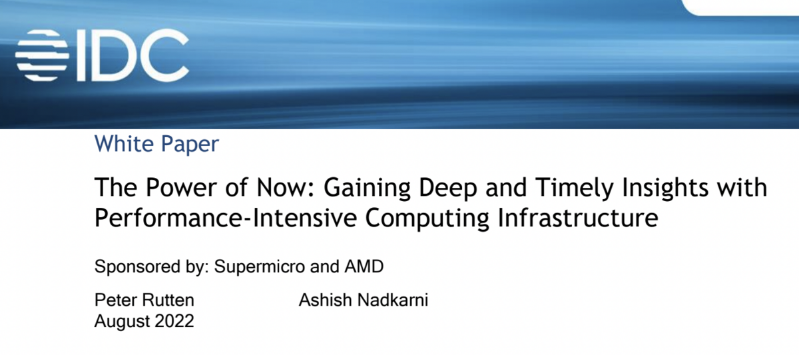The Power of Now: Gaining Deep and Timely Insights with Performance-Intensive Computing Infrastructure
Published on 08 Feb 2023

Based on data-driven insights, enterprises may achieve competitive differences today and in the future. Externally, competitive differentiation is achieved via introducing new goods and services or enhancing current ones through new user interactions and experiences. Differentiation may be accomplished internally by reducing and improving corporate procedures. Being data-driven shortens the time to value insights, producing top- and bottom-line effects for the organization.
Performance-intensive computing infrastructure (PIC-I), which is required for scaling artificial intelligence (AI), Big Data and analytics (BDA), modeling and simulation (M&S), and engineering applications such as electronic design automation (EDA), is gaining traction in large and small businesses, as well as across all organizational entities (corporations, governments, universities, nonprofits). The key service-level aim for infrastructure is a performance at scale.
For an organization to acquire meaningful insights from vast and/or heterogeneous data sets at the scale referred to, a performant infrastructure must be created from the bottom up. Furthermore, corporations often implement PIC-I separately from their corporate IT infrastructure since the execution of these applications should be good.
Performance-intensive computing (PIC) systems are typically batch-oriented. Still, they are increasingly being redesigned to include a (real-time) streaming analytics component, making the service quality of the underlying infrastructure even more vital. Regardless of how modern or efficient it may be, infrastructure meant for general use is not intended to support PIC applications. Rather, it is intended to provide steady company operations by providing the service quality necessary for business- and mission-critical revenue-generating applications.
PIC workloads have been validated for scalability, performance, and security in several public cloud installations, where enterprises may often conduct preliminary development and testing. IT purchasers are interested in deploying PIC-I solutions on-premises or in colocation facilities. They aim to concentrate on business results with the same value, performance/watt, security, and sustainability goals as the public cloud. Thankfully, IT suppliers are rising to the challenge. For instance, silicon manufacturers like AMD and its solution partners, such as Supermicro, have created infrastructure solutions tailored for PIC applications.
According to IDC, the major reason for failure in many PIC projects (such as AI, for instance) is a need for more knowledge and inadequate investments in purpose-built infrastructure. Companies must also recognize that for PIC projects to be effective, the effects of data gravity and relevance must be included in deployment decisions. Businesses must invest in the proper infrastructure stack as part of their IT strategy to overcome the impediments to widespread and secure PIC implementations.
Building Infrastructure for Performance-Intensive Computing
Several previously identified use cases need a three-step approach to be operationalized: technology, organization (people), and procedure. A lack of awareness of the crucial people, processes, and technological competencies necessary for success is a major obstacle that companies face when they operationalize many of the new workloads, particularly when managing the life cycle of the applications and accompanying data. Moreover, security and energy efficiency is gaining prominence on the IT agenda.
It demands new processes and organizational methods, such as investing in communication between the business and technical teams, and between the development and operations teams. Using artificial intelligence as an example, enterprises must scale their AI operations, including workflow cooperation, model prototype and training, model deployment, model performance assessment, and continuing model monitoring.
There are five technological areas that firms must assess as part of their PIC-I strategy. They must take a comprehensive strategy by considering the following:
- Software solutions and platforms that provide foundational functionality for further app development and assist in bridging the divide between developers, data scientists, and IT operations teams.
- Purpose-built infrastructure able to increase performance to meet the growing computation and data durability needs of the applications
- Locations for infrastructure deployment to allow ubiquitous consumption and organization-wide analytics
- Silicon-level security solutions enable enterprises to adopt a contemporary strategy for reducing threats to valuable assets, mitigating malware, and protecting against internal and physical assaults.
- Investments in technology that match the company's environmental, social, and governance (ESG) objectives (By implementing energy-efficient designs, IT businesses may contribute to achieving these objectives while still fulfilling business requirements.) Infrastructure is among any PIC task stack's most misunderstood and undervalued components.
It is also one of the leading causes of failed PIC initiatives. IDC research demonstrates, for instance, that in the early days of AI, enterprises did not agree on the infrastructure best suited for executing their AI workloads. As a consequence, they tried everything with often disappointing results. Cloud service providers and hyperscale data centers with AI capabilities have the luxury of expanding their AI and HPC workloads with huge amounts of general-purpose servers. They also employ large IT teams to ensure the infrastructure's service quality.
Most businesses cannot imitate such methods, and efforts to do so often result in the failure of their AI projects in production. Building a more performance-oriented infrastructure for these performance-intensive apps and workloads is the best answer since running them on a general-purpose infrastructure would not give the scale required to get significant insights and, therefore, a competitive advantage.
Download IDC's whitepaper to learn more about cloud infrastructure service only on Whitepapers Online.
